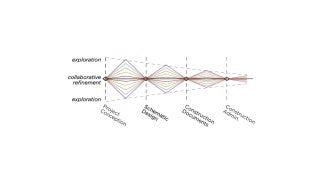
How to take advantage of this cross-cutting tool for architects
With the Integrated Design Process (IPD), architects can tackle complex problems and audacious goals.
More than just a tool, the Integrated Design Process (IPD) is a paradigm, a way of looking at the world. It’s an approach that ensures synergistic, multilateral thinking—a cross-cutting approach—and provides the means to advance promising ideas and strategies, while discarding others that aren’t useful. At our firm, evolveEA, we use this approach when dealing with complex problems and strategizing to meet audacious goals. Best of all, architects are well-suited to lead efforts providing this valuable service.
What is IDP and how do I use it?
Big, ambitious projects are great candidates for the Integrated Design Process.
A good first step is to identify the project's main stakeholders and bring them together for a facilitated discussion. A face-to-face charette (or workshop) carries a logical arc from the client's exploration stage and gives structure to their goals. Once these goals are established, you and the client can start to discuss your strategy.
In addition to subject matter experts and the design team, owner participation is essential. Many architects are hesitant to explore partially-baked ideas with owners in real time, but this misses the point of the exploration. In the words of my friend and IDP authority Bill Reed, AIA, the charette is where architects go from being experts to being co-learners. Humility goes a long way.
Strategies can be shaped by frameworks. One outcome of a charette can be an Owners' Project Requirements document, which organizes the goals and strategies of the project around desired benchmarks like energy efficiency, community impact, water efficiency, health outcomes, and more.
Once you've started with a mission statement, which has lead to goals, then to frameworks and strategies that will address those goals, the next step is to assign metrics that address the strategies—for example, dollars saved per year for ROI or Water Use Intensity. Healthy interiors metrics could be related to air quality, low particulate matter and VOCs.
Why involve so many people?
It can be daunting and expensive to see a room full of assembled experts. The design and construction team should be well-represented in order to address the questions and issues that arise from stakeholders.
Once the charette is completed and has been documented in the form of Owners Project Requirements or a Summary Report, the charge is to integrate these strategies into the project. Not all answers are solid this early in the project, but items to explore should be apparent. From this point forward, the documents should provide guidance, and are intended to be modified as you continue to explore strategies.
Why don't we have the charrette later in the process when we know more about the project?
The purpose of a charrette early in the process, ideally before any sketching takes place, lies in the inverse relationship between the ease of making changes early and the cost and disruption of making changes further along in the process.

Project meetings to discuss the project goals should be held regularly and at milestones. As design decisions become solidified through the course of the project, the ability to make changes becomes more difficult and costly. Aside from confirming forward movement, this process is equally useful in noting ideas that may have been explored, but not implemented.
As charrettes occur, the bracket of possibility becomes smaller with each successive charrette. On a Living Building Challenge project that we managed, we clearly had the owner's voice in our heads, saying "no shortcuts." While exacting, this made for a more streamlined process, as we didn't bother considering substitutions that would ultimately be rejected.
The project is complete; what now?
This is a tough part of the process. The design and construction team is generally disincentivized from doing too much follow-up. The fee is exhausted, the project works and is in the books, and other projects demand our attention. The paradox is that while this is how our industry works, this specific time after project completion is particularly rich to determine the success of the project. How well were the goals achieved? What worked or didn't work? Can a post-occupancy survey or evaluation be performed? How can any lessons learned apploy to the owner's next project and contribute to the firm's institutional knowledge?
Do charettes have to be in person?
"Charettes are far more effective when held face-to-face" is an answer we would have given until a few years ago. In the post-Covid era, we've found that virtual rooms allow everyone to follow along with a presentation while being able to write their ideas and post them. This negates the too-typical 20% of participants doing 80% of the talking; with this approach, everyone can have their say. What's more, the virtual board can be left open for access after the charrette, allowing participants to return with more ideas or refinements.
The takeaways
The IDP approach and terminology mirror much of the architect-led delivery process. The architectural formation and discipline is rich in lateral thinking, facilitation, creativity, concept integration, and form-making, making architects able to handle and simplify complex concepts and issues. Architects listen actively, while finding patterns, determining conclusions and advocating clearly. Architects are able to see the big picture and think in systems over time. What's more is that architects are typically at the table when projects are being conceived, giving us the ability to help shape larger forces.
The Integrated (or Integrative) Design Process has been recognized by LEED and the Living Building Challenge frameworks, as well as being a registered ASTM International process. This steady-improvement mechanism, when codified, can be used for any problem and any scale.
A maxim of the regenerative practitioner, attributed to President Eisenhower, states, "If you’re having trouble solving your problem, enlarge the problem." With this paradigm, blight, hunger, poverty and inequality are all problems to be solved. Buildings are great targets for this approach, but so are the larger systems that they inhabit.
Marc Mondor, AIA, is principal and cofounder of evolveEA, a green building and sustainability building and design firm. He currently serves on the AIA Strategic Council and is past president of AIA Pennsylvania.
